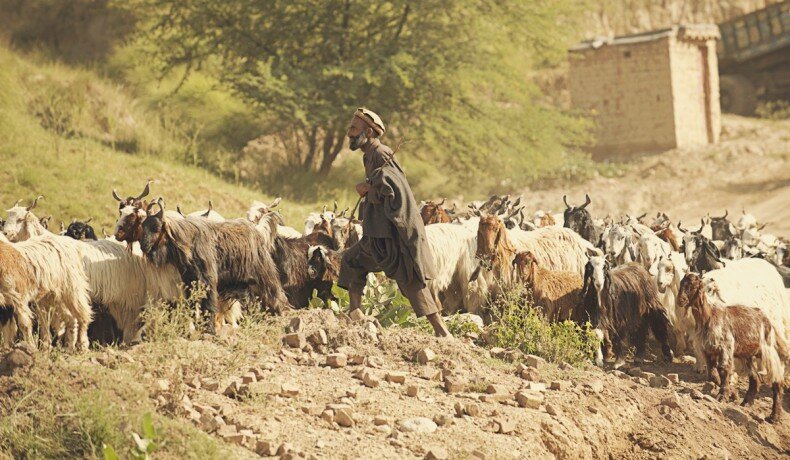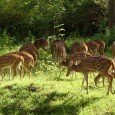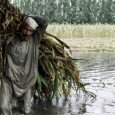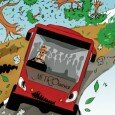By Haroon Janjua –
How climate change affecting livelihood movements of nomads
Nomads with herds of animals camp down along the green fields of Hazara and northern Punjab, Pakistan from June to October. During their short stay near water channels to camp and rest in long schlepping, the Gujjar nomads remain on the move to earn their living from livestock.
Living in primordial settings without safe houses, they have to endure number of common disasters and environmental change-instigated catastrophes. The nomads are truly helpless and frequently lose their persons and domesticated animals amid regular movements.
 Climate conditions and seasonal foraging options determine pasturing practices as the movement of herds between higher pastures and the Potohar Plateau, in the foothills of the Himalayas. These herds utilize the period as a part of the center of June and October in high ranges, and when low temperatures hinder plant growth, herders plunge towards the fields or low valleys. In winter season, the nomads stay near water channels, forests and green fields.
Climate conditions and seasonal foraging options determine pasturing practices as the movement of herds between higher pastures and the Potohar Plateau, in the foothills of the Himalayas. These herds utilize the period as a part of the center of June and October in high ranges, and when low temperatures hinder plant growth, herders plunge towards the fields or low valleys. In winter season, the nomads stay near water channels, forests and green fields.
The herders normally known as “Bakarwals” pay a nominal grazing fee to the Syed families of Kaghan or the Khans of Indus Kohistan who own these alpine pastures. Overstocking, this is common in the region, has greatly reduced the grazing capacity of these rangelands.
Zulfiiqar, a shepherd since childhood, has twice survived landslides. He recalls, “While moving from Skardu to reach the top of a hill, torrential rains caused a landslide, I ran down, in order to prevent myself from getting buried in the debris of the landslide, however hundreds of sheep from my herd were buried and perished. I was fortunate to escape from that fury of nature.”
These beautiful colorful nomads live amicably and in harmony with Mother Nature, and their large herd of sheep and goats, which is a striking feature of their presence. Many groups among them endeavor to travel and migrate by strolling, completing weeks-long journey, in spring and fall.
These wanderers, anthropologists believe, descended from the Old Turkic tribes of Central Asia and are known throughout the mountainous regions of Hindu Kush, Karakorum and Himalaya. Their life revolves around the prosperity of their livestock which they rear in the fields during winter season, strolling them into the high mountains during the late spring season when climate in the fields is excessively hot for them to survive comfortably.
A very low estimate by Merlin (UK based NGO) in 2006 estimated the number of Bakarwal in Pakistan to be 20,000 but this is believed to be a very conservative estimate.
 Yasmeen, 46 told devastating climate change effects on their lives during their movements. She explained “In the past four years, we have lost many of our children because of severe rainfalls and cold”. She remembers that since 2010 the rainfall has been heavily increased and five children under 3 years of age died of pneumonia. She further explains “not only children, my mother also died because of terrible cold in 2012 during our movement in Kashmir.”
Yasmeen, 46 told devastating climate change effects on their lives during their movements. She explained “In the past four years, we have lost many of our children because of severe rainfalls and cold”. She remembers that since 2010 the rainfall has been heavily increased and five children under 3 years of age died of pneumonia. She further explains “not only children, my mother also died because of terrible cold in 2012 during our movement in Kashmir.”
The Gujjars Nomads represents the best continuity with pre-industrial modes of production and ancient livelihoods within the present time. This informal economy, constituting sustained interaction and adaptation with specific geographical locations and ecosystems, exists among the longest-standing and most established samples of “sustainable development” within the ordinal century.
Severe climate challenges taking lives
Given their close and harmonious bond with ecosystem, nomads groups are the custodians of the environment; yet, the powerful environmental activism post WW2 has virtually ignored them. Part of the problem is their focus on the causality of man’s destructive interventions on environment rather than how environmental degradation endangers humans.
Climate change, as a global challenge, is affecting nomadic people severely, given their isolated habitats. With its fragile and harsh ecology susceptible to climate change due to its latitude, topography, distance from the sea, soil’s quality, etc. A change in rainfall patterns is striking the vulnerable and poor the most, especially the nomadic communities, farmers’ herders, and fishermen, vulnerable to diminishing sources of livelihoods.
 Ghulam Mustafa, 34, with herds of goats and sheep travel every season with his family. Lamenting his predicament he said, “We lose our 50 animals in every season due to difficult journey and adverse weather conditions. In 2009 while moving from Kashmir, my cousin Shabbir fell asleep on cliff. When he rolled on his side, he fell in river and his body was never recovered from the river. We frequently travel and only stay for an hour to eat meal. There are many such incidents but I remember some of the fresh incidents.”
Ghulam Mustafa, 34, with herds of goats and sheep travel every season with his family. Lamenting his predicament he said, “We lose our 50 animals in every season due to difficult journey and adverse weather conditions. In 2009 while moving from Kashmir, my cousin Shabbir fell asleep on cliff. When he rolled on his side, he fell in river and his body was never recovered from the river. We frequently travel and only stay for an hour to eat meal. There are many such incidents but I remember some of the fresh incidents.”
Climate change is obviously not simply a natural issue, however one with serious financial ramifications. Nomadic communities are already vulnerable and marginalized.
A study of nomads can reveal some of their skills and capabilities in observing, interpreting, and adjusting to climate changes. Incisive and sharp traditional knowledge with which they often build key decisions and adapt priorities, they now have a rich collection of learning on environment. Researchers are presently gaining knowledge from their natural brainpower and points of view on environmental change in the Arctic regions. These studies confirm that climate variations observed by nomads groups or empirical observations are, for the most part, in accord and often provide mutually reinforcing information.
Deploring health issues
 The nomadic group of population is deemed the vulnerable community. Distribution of risk is therefore is more skewed towards the nomadic communities as opposed to the rest of population. Nomadic groups regularly experience the ill effects of poorer wellbeing, are more inclined to experience disability and diminished personal satisfaction and at last live shorter due to various hardships in their lives.
The nomadic group of population is deemed the vulnerable community. Distribution of risk is therefore is more skewed towards the nomadic communities as opposed to the rest of population. Nomadic groups regularly experience the ill effects of poorer wellbeing, are more inclined to experience disability and diminished personal satisfaction and at last live shorter due to various hardships in their lives.
PAHO has stated that “The present epidemiological profile of the indigenous population is associated with high poverty indices, unemployment, illiteracy, migration, exclusion from the mainstream society, lack of land and territory, destruction of the ecosystem, alteration of the dynamic of life, and unmet basic needs”.
If delved into the underlying causes of health disparities between nomadic and non-nomadic groups and provide an Indigenous perspective to understanding these inequalities, an evidence of the many researches indicate migrant nomads’ suffer from mental health and addictions; urbanization and environmental stresses. The underlying cause of health issues is lack of education, availability of employment opportunities and the poverty.
![]() The writer is a freelance journalist based in Islamabad. He tweets at @JanjuaHaroon
The writer is a freelance journalist based in Islamabad. He tweets at @JanjuaHaroon































































































